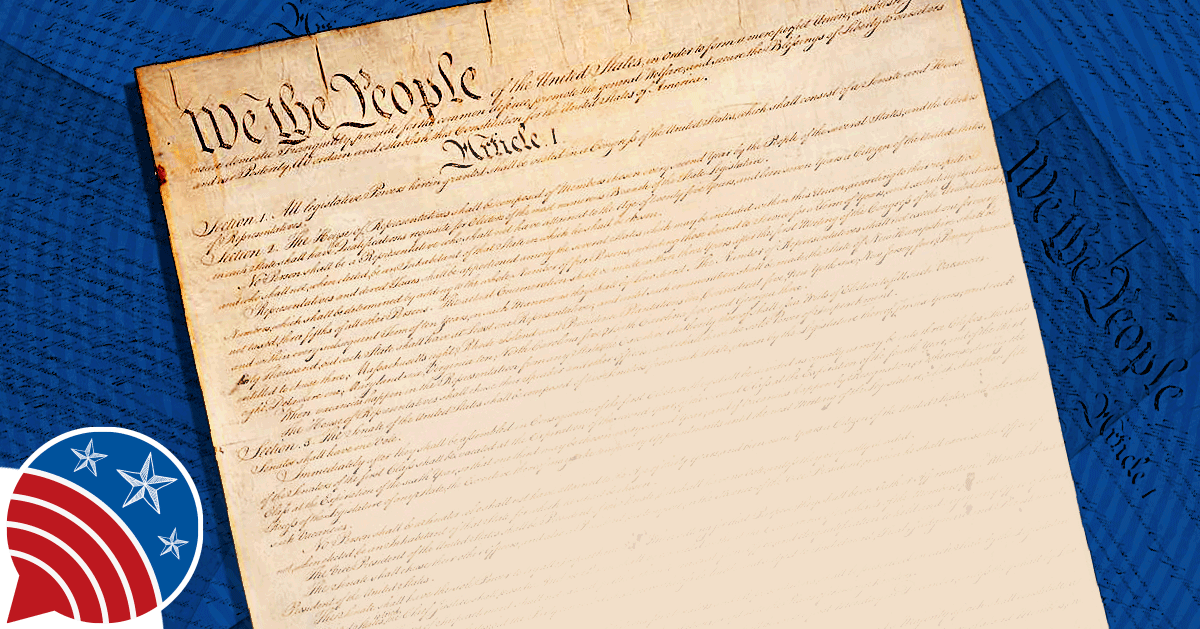
Principles of the Constitution
Session Plan
- Tell students that today we will be examining the Articles of Confederation but to get started we’re going to participate in a simulation activity.
- Ask participants to jot down and discuss the following question: Consider the strengths and challenges of your community. If you had to form a new government, what issues would you address? Make a list of the top ten priorities, in order of significance to you.
- After 5-10 minutes of quiet work time, direct participants to small groups. Inform them that they are to work with their group members to solidify a list of priorities that incorporates the ideas of each member.
- After 5-10 minutes of quiet work time, direct participants to partner with another group in the room. Inform them that they are now tasked to incorporate the ideas of their partner group into a new list of ten priorities. Repeat this process once more, depending on the size of the group.
- Ask participants to choose a group speaker to share their list with the whole group.
- Debrief the simulation/process with the participants.
- (Show of hands) Did your group’s final list reflect the priorities you started off the activity with? If not, what differences emerged?
- What are the strengths of this decision-making process? Challenges?
- If you had to reimagine this activity/process, what changes would you make to ensure more effective decision-making?
- Chart Paper (1 sheet/group)
- Markers
- Sticky Notes
Tell participants that today we will be focusing on some of the big issues and ideas America has struggled with since the early days of the United States of America.
Option 1: Whole Class Exploration
- Share the first podcast, “Need for a New Constitution” with your students.
- While they view/listen to the recording, ask students to pay attention to references being made to the shortcomings of the Articles of Confederation.
- After watching/listening to the podcast, ask one student to share out a brief summary of the ideas and topics discussed. Prompt additional students to correct or expand upon the shared summary.
- Repeat this process for the remaining four podcasts adding questions and wonderings to fuel reflection and inquiry, based on each of the 60-Second Civics podcasts.
Option 2: Small Group Activity
- Divide the class into small groups (4-5 students each). Prior to the activity, set up “stations” with each station stepping up with one of the four remaining podcasts. Assign each group to a specific station.
- Podcast episodes can be cued up with a link or QR code on the paper. Students can use phones or devices, or tablets can be set at each station.
- Tell each group that they will have five minutes at each station until they are prompted to rotate.
- When they arrive, they will have one minute to actively listen to the podcast (taking notes on key points, interesting facts, or any thoughts that arise). At the end of the podcast, students will have four minutes to write down their reaction questions and thoughts on that station’s chart paper.
- After five minutes, students will be prompted to rotate counterclockwise to the next station.
- Repeat steps three and four until each of the stations has been accessed by each of the groups.
- Each group will have five minutes to review the reflection notes found on the chart paper at their final station.
- Prompt groups to identify any trends or common reactions on their chart paper.
- At the end of the five minutes, ask each group to share their findings.
- Open a whole-class discussion to elevate questions, wonderings, and key ideas.
Extension Opportunity: The Constitution of the United States
- Depending on students’ background knowledge, cue students to search through the Constitution to find ways issues from the Articles of Confederation were remedied by the Constitution.
- Make a chart of compare and contrasts to be used later in the civil dialogue.
Extension Opportunity: Beyond the Legacy Video Guide
- After discussion of the 60-second podcasts, share the Beyond the Legacy Video: Principles of the Constitution. Use any or all of the questions noted below and additional questions in the resource Beyond the Legacy Video Guide: Principles of the Constitution.
- What were some of the major compromises that needed to be made at the Constitutional Convention in 1787?
- What problems was Madison trying to solve in his proposal for a new government?
- How did the compromises made at the Philadelphia convention affirm the constitutional principles we have today? What were these principles?
- What type of government did the new constitution create? What were some of the criticisms of it?
- How does Madison distinguish between a republic form of government and a direct democracy? What form of government does the Constitution provide?
- Describe the roles and arguments of the Federalists and Anti-Federalists in the battle for ratification of the Constitution.
- How are some of the Anti-Federalists' arguments still relevant today?
Now that participants have been exposed to references to the Articles of Confederation and some of the other issues associated with governance in early American history, transition to a review of that text to deepen their understanding of the nature of constitutional principles.
- 60-Second Civics Podcast: Principles of the Constitution
- The Articles of Confederation (1777)
- Beyond the Legacy Video: Principles of the Constitution
- Beyond the Legacy Video Guide: Principles of the Constitution
- Chart Paper
- Markers
- Sticky Notes
- Interactive Whiteboard
- Digital Collaboration Space
Discourse Launch Activity
Note: The following steps are the beginning of the Paideia seminar process, which entails taking a deep dive into the text. Whether doing the Paideia or the Structured Academic Controversy (SAC) as the discourse model (or both) these steps provide the opportunity to access the text for use in either discourse activity.
- Begin by asking participants to jot down and discuss the answers to the following questions:
- If you were to create a new government, what is one guiding principle you would want to ensure it has (e.g. limited power, protections or rights, equal rights, etc.)
- Why is this principle important?
- Have a brief class discussion to explore their understanding of constitutional principles such as the rule of law, limited government, equal protection, separation of powers, etc.)
- Introduce the Articles of Confederation excerpt or full text.
- Text Support Option: Teachers can use the Close Reading Template to add the text which provides a strong framework for analyzing and understanding complex text. In using this template, teachers will need to develop text-dependent questions to support students’ comprehension. This is a powerful tool to support literacy in all learners in addition to scaffolding in preparation for the civil discourse.
Primary Text Inspectional Read
- Distribute the text, Articles of Confederation. Discuss with participants what they anticipate the text is about.
- Have them number the paragraphs in the text. Then ask participants to read the text while highlighting unfamiliar words and phrases.
Vocabulary
- Have participants share the words and phrases they found unfamiliar while a volunteer lists them on the (interactive) whiteboard. Be sure to include:
- “be not infringed”
- confederation
- equipage
- garrison
- impositions
- imposts
- judicial proceedings
- jurisdiction
- magistrates
- sovereignty
- Use your preferred practices for front-loading vocabulary comprehension in a complex text.
- Alternatively, assign the words and phrases to groups of participants to research and define.
- Have the groups share with the entire class and discuss until all participants are comfortable with the surface meaning of the text.
Analytical Read
- Have participants read through the text selection again, slowly highlighting the three most impactful lines or sentences.
- Then in the margins of the selections, ask students to write notes on what makes those lines or sentences so compelling.
- Chart Paper (1 sheet/group)
- Timer (optional)
- Sticky Notes
- Markers
- The Articles of Confederation (1777)
- Highlighters
Note: Choose one or both of the discourse models below.
Civil Discourse Model #1
- Paideia Seminar: A Paideia Seminar is a collaborative, thought-provoking dialogue about a text selection, facilitated with open-ended questions. The main purpose of the seminar is to arrive at a fuller understanding of the textual ideas and values, of ourselves, and of each other. The discussion occurring over days 2-3 will be on the Articles of Confederation. Participants will make active connections between the ideas present in the document and the impact of these ideas on our lives today.
Civil Discourse Model #2
- Structured Academic Controversy (SAC): In the structured academic controversy, participants are assigned a stance on a question and work to come to a consensus on a contentious issue. The strategy reinforces the idea that before people commit to a side, they should seek to understand the argument of the other side. The goal of a SAC is not to win; rather, SACs should give participants adequate time to present content knowledge and diverse perspectives as well as time for clarification questions, small group discussion, large group discussion, and consensus building. The predetermined format allows for structure and support for multiple viewpoints to be heard, understood, and validated while informing everyone’s views on the question of if the Bill of Rights is more important than the Constitution in our nation's history.
- Paideia Seminar Plan – Articles of Confederation
- Option: Use the Paideia Plan template and engage with a different text such as the Constitution or combine the use of two texts.
- Highlight some of the ideas discussed during the previous day’s discourse model(s). Be specific and explicitly connect comments and ideas to the participant that shared them.
- Return to the Inquiry question:
- Do our constitutional principles still matter today?
- As a pre-writing exercise, participants should be encouraged to revisit notes they captured on the margins of their text selection, personal recording space, etc. and during the Launch Activity to refresh their memories of earlier discussions on this topic.
- Select one or both activities below to assess and authentically engage participants as you conclude this discourse.
Writing Task
- Write a paragraph (or more) to the authors of the Articles of Confederation sharing how one or more of the Constitutional principles have shaped our country. How might our country and its history be different if we had kept the Articles or if the Constitution did not support that particular principle?
or - The Bill of Rights served as a compromise to help two sides believe they were both achieving their goal of creating a better version of the United States government. Does a compromise like that feel possible today? What could we learn from the Federalist vs Anti-Federalist debate that would make our country stronger today? Write an argumentative essay (or another form of expressive work like a PowerPoint presentation or a Public Service Announcement video) that provides the key reasons why you believe there are ideas related to the Federalist vs Anti-Federalist debate that would strengthen American democracy. Focus on the included texts and podcasts, issues raised in related readings, and during the SAC, as well as your background knowledge on your stance.
Extension Task
- Identify and analyze a policy from your community/local government that you believe requires a rewrite. Create a visual or multimedia presentation that explains the existing issue and your proposed rewrite of the policy. Which constitutional principle(s) are at play? How well have they been upheld in this instance?
or - Identify a key policy debated at any level of government that could be strengthened through compromise, and outline what that compromise could look like using ideas from at least two political parties. What would the Federalist and Anti-Federalist stances be on this modern issue?
or - Select a key principle of the Constitution and identify why this principle was important to the writers of the Constitution and where the inspiration for this idea came from. Using examples throughout American history, explore what this principle has looked like since 1787 and how the understanding or implementation of this principle has changed over time. Evaluate how well this principle is upheld today. Key principles of the Constitution include:







